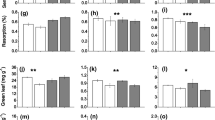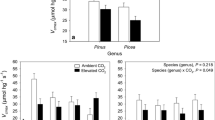Abstract
Black and white spruce (Picea mariana and P. glauca) exhibit a striking micro-geographic distribution pattern at the southern edge of the boreal forest. Black spruce grows in flooded nutrient-poor muskegs, while white spruce is found primarily on drier upland sites, and the two rarely form mixed stands. In an attempt to characterize the physiological and, hence, mechanistic basis of this pattern, we sampled five adjacent populations of black and white spruce from northern British Columbia and measured a suite of physiological and allocative characteristics, and associated trade-offs, that may be important to survival in habitats limited in nutrient or water availability. Two laboratory experiments were conducted: a greenhouse dry-down experiment to assess relative degree of drought tolerance; and a 2×2 nested factorial experiment in which seedlings were subjected to varying water and nitrogen regimes for approximately 16 weeks. White spruce was more drought-tolerant (i.e., maintained positive net photosynthesis at lower shoot water potential) and more efficient in water-use (as indicated by carbon isotopic composition) than black spruce. Black spruce was found to be significantly less sensitive to nitrogen stress, exhibited greater plasticity in nitrogen-use efficiency (measured as the carbon-to-nitrogen ratio in total plant tissue), and had a greater specific N absorption rate under high-N conditions than white spruce. Trade-offs hypothesized to be associated with these nitrogen and water relations traits were examined, but few were confirmed. Water-use efficiency and nitrogen-use efficiency did not trade-off between species, but did trade-off plastically (i.e., across treatments) within species. When exposed to simultaneous limitations of N and water both species were forced to utilize each resource with suboptimal efficiency. The change in isotopic composition per unit change in C/N ratio was not the same in the two species. This difference may reflect optimization of the trade-off, whereby each species maximizes the use efficiency of the most limiting resource (respective to its habitat), while minimizing the concomitant reduction in the use efficiency of the other resource.
Similar content being viewed by others
Author information
Authors and Affiliations
Additional information
Received: 10 June 1996 / Accepted: 8 October 1996
Rights and permissions
About this article
Cite this article
Patterson, T., Guy, R. & Dang, Q. Whole-plant nitrogen- and water-relations traits, and their associated trade-offs, in adjacent muskeg and upland boreal spruce species. Oecologia 110, 160–168 (1997). https://doi.org/10.1007/s004420050145
Issue Date:
DOI: https://doi.org/10.1007/s004420050145




